Every individual has a lifestyle that is made up of different variables such as diet, way of styling, and living in a certain way. It is subjective to every individual. If we take one variable, that is diet, we know that every individual has a different diet and way of mixing up things. A diet can be a simple one or a special one. Whatever diet it is, we know that vegetables are a major and integral part of every diet and every lifestyle. Without the inclusion of vegetables, one cannot complete their diet. Everyone has their favorite vegetables that they like to include in their diet. To know about the preferences of different people regarding vegetables, a vegetable tier list is needed in action.
A vegetable tier list will help us to gather data about different vegetables, and why and how they are ranked in different tiers. Let us not forget that, every tier list is subjective to every individual, and one tier list may not be the criteria of another person thus our tier list is open for suggestions but not criticism.
Key Points
- There are a total of 28 entries in the article.
- We will rank all the vegetables in the article according to their harvesting period, need for attention, and favoritism.
- In the highest tiers, you will see vegetables like Boy Choy, Kale, Potato, and Carrot.
- Among the lowest tiers, you will observe vegetables like Broccoli, Capsicum, Asparagus, and Spinach.
Summary
We will rank all the vegetables in a short table below.
| S Rank | A Rank | B Rank | C Rank | D Rank | E Rank | F Rank |
|---|---|---|---|---|---|---|
| Boy Choy | Mushrooms | Corn | Raddish | Malabar spinach | Beetroot | Broccoli |
| Kale | Seaweed | Green beans | Parsley | Peas | Capsicum | |
| Potato | Bell Pepper | Avacado | Turnip | Keto vegetables (Bonus) | ||
| Carrot | Tomatoes | Cauliflower | Asparagus | |||
| Eggplant | Lettuce | Scallions | Celery | |||
| Spinach | ||||||
| Mushrooms |
Learn more about each entry by reading on.
S Tier
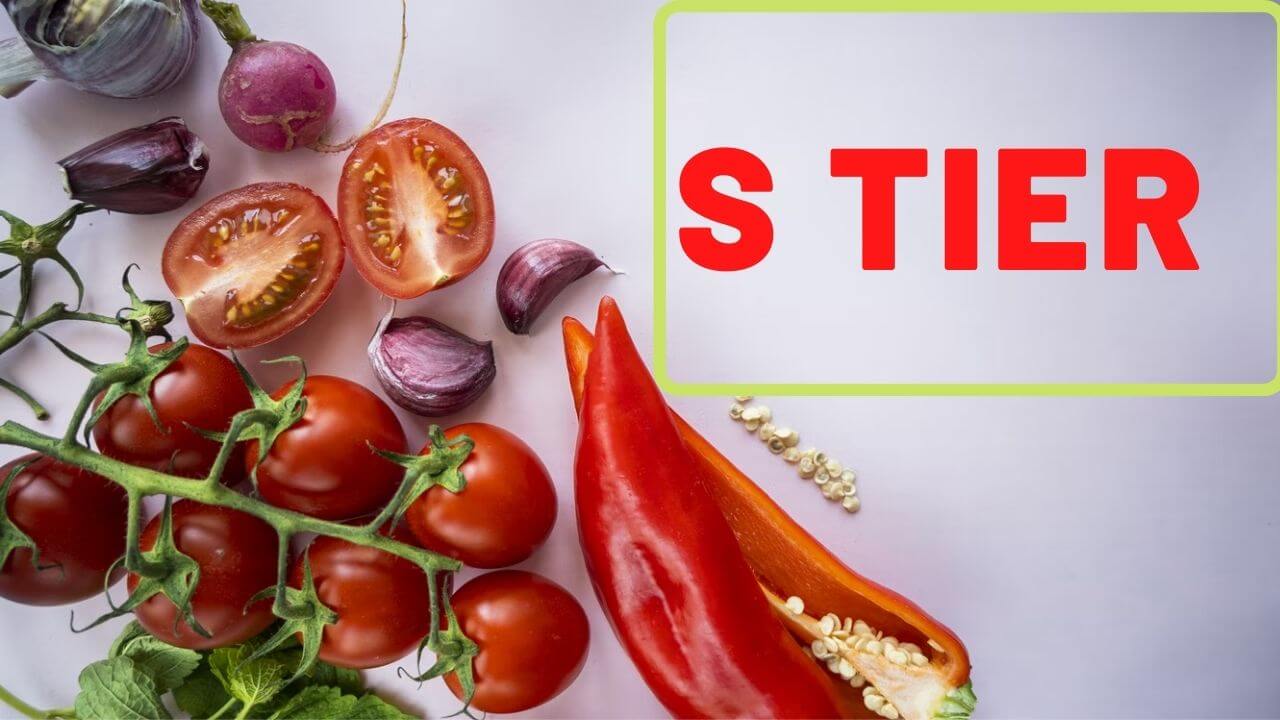
The first tier in the vegetable tier list that we are talking about is the S-tier. S-tier vegetables and fruits are the most elite and powerful class of crops. Only four crops alone just by themselves would be enough.
They can be pooled with other crops such as perennial and some wild vegetables. They require less attention and grow easily. Vegetables in the S-tier are also in less need of pesticides and fertilizers.
Below, we have listed the top S-tier vegetables.
Boy Choy
Let us talk about the first vegetable in the S-tier vegetable list which is the bok choy. Starting with a brief introduction, the bok choy belongs to the family of pak choi. It is known as a leafy vegetable family. This family originates from Chinese brassicas. Bok choy is also known as white chine cabbage.
The structure of the bok choy is beautiful, having green or white thick stems along with wide leaves that vary in color from light to dark green.
Bok choy has been added to the S-tier vegetable list for several reasons. The first reason is that its harvesting period is quite long. Having said that, the second reason for its ranking in the S-tier is that it does not require a lot of attention. Last but not least, this vegetable is liked by a lot of people from all over the world. They add it to their daily meals and enjoy eating it.
| CALORIES | 9 |
| PROTEIN | 1g |
Kale
The second vegetable that we have put in the S-tier category is kale. Kale is famous for several reasons and the health benefits that it provides to its admirers. It belongs to the cabbage family and is known as a cruciferous vegetable just like its siblings cabbage, broccoli, and cauliflower.
Kale comes in a variety of forms. Each of these forms is loved by people. It is liked by people a lot and they add it to their salads. But the question is why we have added kale? It requires less attention and care. Kale also consumes fewer pesticides and fertilizers. It does not bear damage easily and can stay fresh for a longer period.
| CALORIES | 49 |
| PROTEIN | 2.21g |
Potato
Potato is also known as a starchy tuber of a plant known as Solanum tuberosum. It is a root vegetable that is native to the Americas. Potato has made it to our vegetable tier list because of its certain qualities.
First of all, potato takes less time to grow, and it also needs less attention. This means that one does not need to constantly keep a check on the plant to prevent it from getting any damage. Potatoes are less likely to get damaged if they are kept properly. They also consume less amount of pesticides and insecticides.
Potatoes are also liked by a lot of people from all over the world. Whether boiled or fried, they are the absolute favorite go-to snack.
| CALORIES | 110 |
| PROTEIN | 1.5g |
Carrot
A carrot also known as Daucus carota, is another vegetable that has made it to our S-tier. This vegetable is packed with several health benefits, due to which it is liked by a lot of people from all over the world. According to people, a carrot is a portion of perfectly healthy food.
Carrots are crunchy in texture, good in taste, and are a hub of many nutrients. They are a primary source of good amounts of beta carotene, fiber, vitamin K1, potassium, and antioxidants. Carrots are rated as the best vegetables by people.
They are ways to maintain and cook. Carrots face less damage and require less attention during their growth periods. Pesticides and insecticides are less likely to infect carrots. They can be stored fresh for a couple of days after they are brought home.
| CALORIES | 41 |
| PROTEIN | 0.9g |
Eggplant
Eggplant is also known as aubergines. It is rated as the best vegetable on the internet, by many people. The family of eggplant is a nightshade. Eggplants are consumed by people from all around the world, and they are used in many dishes as well.
The reason for adding it here is that eggplant is packed with several different nutrients. It is highly beneficial for the health and is packed with a lot of antioxidants. It takes lesser time to grow and is found everywhere. Eggplant goes through less damage and it stays fresh for a week if stored properly.
| CALORIES | 25 |
| PROTEIN | 1g3.1g |
A Tier
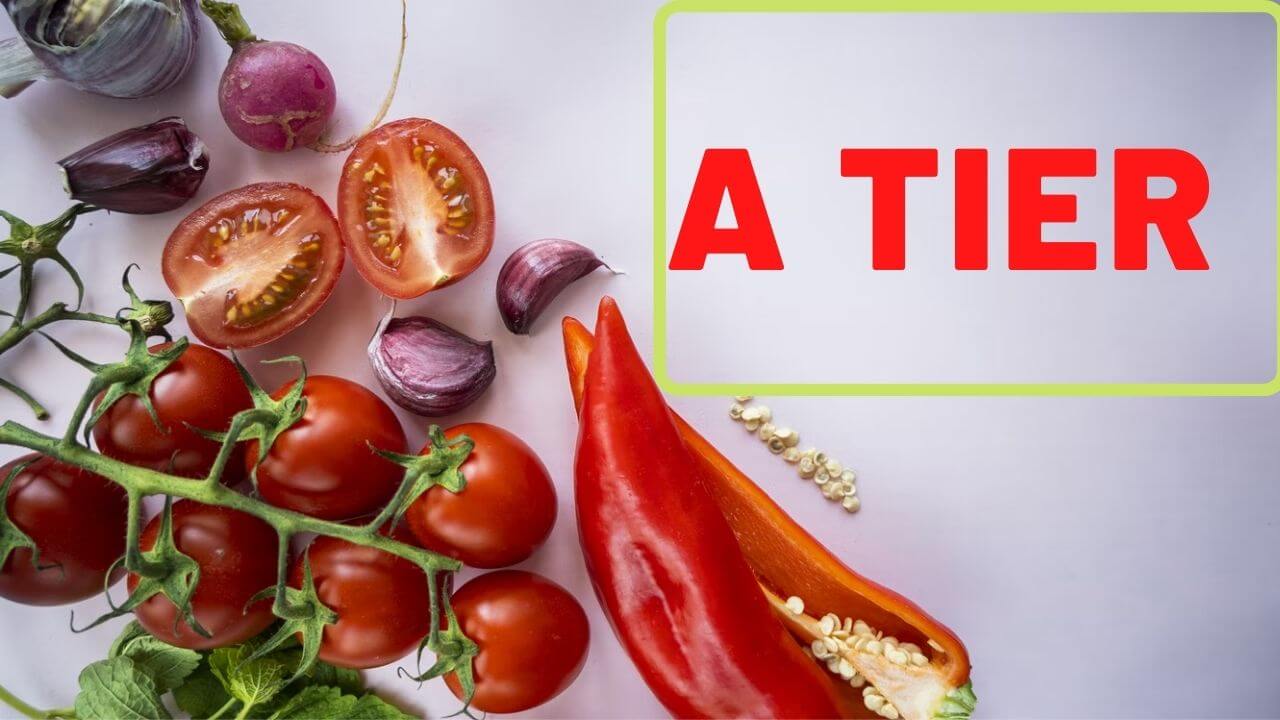
After the S-tier, comes the A-tier part of the fruit and vegetable tier list. A-tier crops are the second most famous category that is liked by people from all over the world. They are powerful and easy to grow. These crops are somehow a bit difficult to manage and would need attention.
A-tier vegetables are established in the winters and then they are allowed to grow during that time. They are then harvested during the summertime. The A-tier fruits are possessed a relatively short harvest window as compared to the S-tier fruits. Pests and insects can affect these crops more as compared to the S-tier.
Below, we have listed the top A-tier vegetables.
Mushrooms
We all love mushrooms, don’t we? Mushrooms are a popular food all around the world, whether eaten as a topping on a pizza or mixed in a salad. Mushrooms can be molded into different forms, according to individual tastes bud.
But why we have added it to the vegetable tier list is a big question mark. To solve the mystery let us know more about its qualities.
Mushrooms take a short period to grow the product and require a bit of attention. The attention will keep it protected from pests and insects. If proper attention is not provided, then the mushrooms can undergo some damage. They also carry important nutrients in them that make them a number choice for many people.
| CALORIES | 22 |
| PROTEIN | 3.1g |
Seaweed
Seaweed might not seem like a vegetable, but the case is the opposite. It is liked by a lot of people and they add it to their daily meals for its health benefits and nutrition. It can be found in a variety of different colors such as red, green, brown, or brown marine. It grows along the seashores and is found at the bottom of the sea.
We have added seaweed to our fruits and vegetable tier list for several reasons. The first reason is that it does not require a lot of care and consideration. And the second reason is that it has low levels of oxalate which makes it an ideal choice for people who are suffering from issues related to oxalate.
| CALORIES | 306 |
| PROTEIN | 2.3g |
We have talked enough about healthy foods and sometimes it is okay to have some junk as well but beware; don’t overdo it. For that, we have the Soda Tier List for you.
Bell Pepper
Bell pepper which is also known as Capsicum annuum or sweet pepper is our first vegetable in the A-tier. It belongs to the family named Solanaceae. Bell pepper is mostly grown to produce mild and thick fruits.
From the nutrition point of view, bell pepper carries a lot of health benefits. It is packed with vitamin A and vitamin C. Bell pepper is used in a lot of salads and other cooking items, especially in Chinese cuisine.
Bell pepper is technically a berry, it comes in three different colors i.e. green, yellow, and red. This vegetable is grown as an annual, but the green pepper is harvested first. Later it can wear any of the mentioned colors.
Bell pepper requires a little more attention as compared to the S-tier vegetables. They are also quite resistant to pests and insects.
| CALORIES | 20 |
| PROTEIN | 0.9g |
Tomatoes
Tomatoes belong to the family named Solanum Lycopersicum. It is an edible berry of this family. Tomato species have originated from the regions of Western South America and parts of Central America.
Tomatoes are used in various ways such as ketchup, salads, tomato purry, etc. They are ranked as the second-best category by consumers for various reasons. Tomatoes are easy to grow, they can be grown anywhere with the right temperature and care. Tomatoes can be grown in a large quantity in a very short time.
| CALORIES | 22 |
| PROTEIN | 1.31g |
Lettuce
Lettuce is a green and leafy vegetable. It is a part of the sunflower family. Lettuce is found in abundance in almost every part of the world. Not only this, its amazing health benefits rank it as a favorite meal of many people.
Lettuce is mostly grown in a colder climate with little care and attention. In the cold weather, the leaves are provided with ample time to grow properly. During each year, almost 23 million lettuce is consumed by people all around the world.
| CALORIES | 15 |
| PROTEIN | 1.4g |
B Tier
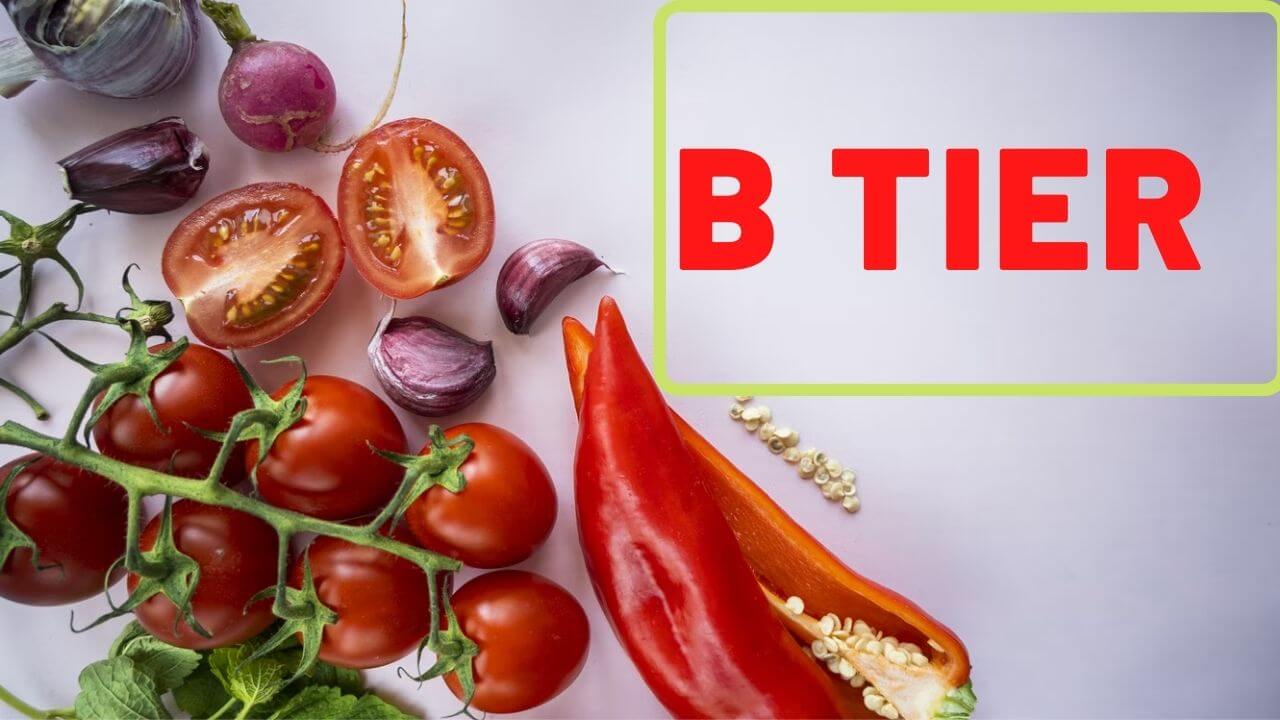
Now let us move towards the B-tier, another interesting part of the fruit and vegetable tier list. These crops are also known as situationally rewarding crops. These crops pose self-sowing tendencies. They are not used a lot for cooking purposes.
These crops on average are found to have a high level of oxalate which makes them fall in the B-tier category. B-tier vegetables are also known as average vegetables, as they are not liked or disliked too much by consumers.
Below, we have listed the top B-tier vegetables.
Corn
Now let us move towards the B-tier vegetables and the first vegetable on the vegetable tier list is corn. We all are huge fans of corn, whether eaten in pasta or eaten like popcorn. Corn is loved by a lot of people all over the world. It is famous for its large and elongated ears of starchy seeds. It is one of the tallest annual cereal grass.
The reason for adding them to the B-tier vegetable list is that corn is vulnerable to pests and insects. They need attention and without proper care, they might be a victim of insects. They are also high in oxalate.
| CALORIES | 88 |
| PROTEIN | 3.2g |
Green beans
Let us provide our audience with a brief introduction to what are green beans. Green beans are the young babies of the parent common bean. They are immature young pods. They are also known as French beans, snap beans, or snaps.
Green beans are added to the B-tier vegetable list for several reasons. They have a high level of oxalate in them. Green beans need constant supervision, if that is not provided they might suffer some pest and insect damage.
| CALORIES | 31 |
| PROTEIN | 1.8g |
Avacado
Packed with several nutrients, avocado is one of the favorite breakfast items of a lot of people all around the world. It has a bright green color on the inside, and a dark texture skin on the outside.
Avacado is issued in the preparation of a lot of food items, be it breakfast toasts, or making hummus. It is rated as an average vegetable due to certain factors.
One is that it takes a while to grow, and is in the need of attention all the time. If done otherwise, the pests and insects will not spare a minute to leave such a tasty meal. Secondly, avocados are not found in abundance and are quite expensive to use on daily basis.
| CALORIES | 240 |
| PROTEIN | 3g |
Cauliflower
Cauliflower is also known as a cruciferous vegetable. It is packed with several nutrients that are essential for a healthy body. they include B-vitamins, vitamin K, vitamin C, and fibers.
Cauliflower is consumed by people all around the world. It is easily available almost everywhere. It is rated as an average vegetable because the fiber in cauliflower can cause constipation and bloat. It is also difficult to maintain and is at a constant threat from pests.
| CALORIES | 25 |
| PROTEIN | 1.9g |
Scallions
You might have come across the vegetable “spring onions”, well they are scallions. They are also known as green onions. Scallions are liked by a lot of fo people for their amazing taste and the extra touch that they add to various meals.
They have a mild taste as compared to regular purple onions, and they belong to the species of Allium.
The reason which they are rated as an average vegetable is that they are quite vulnerable to pathogens. They also require extensive care and protection during their period of growth.
| CALORIES | 32 |
| PROTEIN | 1.8g |
C Tier
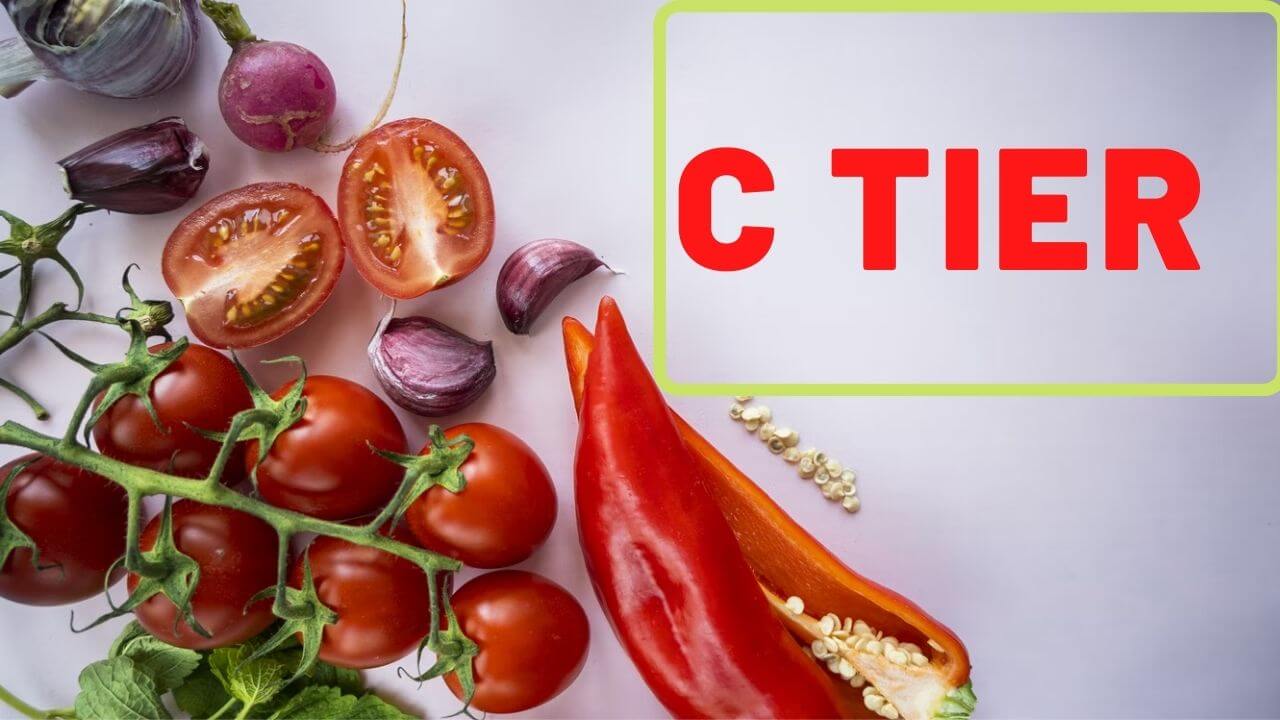
Below the B-tier crops, we have a vegetable and fruit tier list for the C-tier crops. These crops strike a good balance between rewarding crops and crops that have some limitations for people. These crops need a lot of attention, time, and consideration as compared to the tiers mentioned above.
They usually face a hard time growing up. C-tier fruit and vegetable list crops are vulnerable to weather conditions, therefore predicting their behavior is quite a tough job. Pests and insects can easily attack these vegetables if they are not properly monitored.
Below, we have listed the top C-tier vegetables.
Raddish
Let us know about radish, it belongs to the family Brassicaceae, which originated in Asia after Roman times. Raddish is eaten and liked by people from all over the world. they are included in salads and are eaten raw as well in many regions of Asia. They can be grown domestically.
Raddish has made it to the C-tier because it needs a lot of attention and protection against pests. It also has a shorter period of growth. Without proper care, it might get affected by the insects. Along with all of this, it is high in oxalate as well.
| CALORIES | 16 |
| PROTEIN | 0.7G |
Parsley
C-tier vegetables are less fortunate than the above tiers. Parsley is one of these vegetables. It is known as an herb and is added to a lot of dishes such as pizzas and pasta. Parsley comes with several health benefits and is a great source of nutrients for the human body.
Parsley is added to the C-tier list because it can be easily affected by pests and insects. It takes a lot of time to grow.
| CALORIES | 36 |
| PROTEIN | 3g |
Turnip
Turnip is round in shape, white with a purple, red, or pink base. Turnip is found in abundance all around the world. It is one of the staple items of many stews and soups.
Turnip is filled with several health benefits such as Vitamin K, Vitamin C, carotenoids, xanthin, and iron. It is one of the most healthy vegetables on our vegetable lists. But the real question is why it is ranked as below an average vegetable. Let us know why.
Turnip requires a lot of care, and attention during its growth period. Since it grows well under moist conditions, therefore it is at high risk of getting attacked by pests and insects. People who suffer from thyroid gland problems are not advised to eat turnip, as it can cause serious health issues. It has a longer growth period and requires a specific temperature for growth.
| CALORIES | 28 |
| PROTEIN | 0.9g |
D Tier
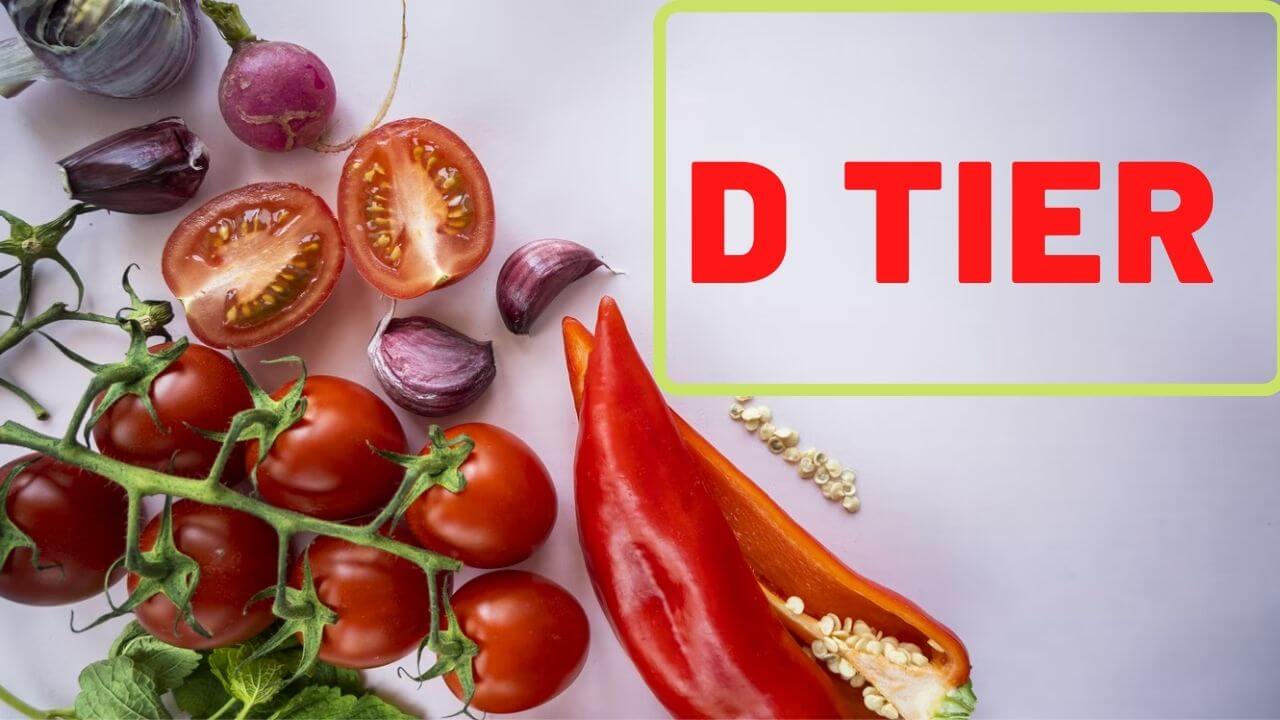
Here comes the D-tier fruits and vegetable tier list. These crops are quite useful and are liked by people as well, but they also have great issues in the package with them. They have a very high level of oxalate in them. These crops will either grow very quickly or they will take a longer period to reach the stage of maturity.
These crops need constant checking, such as picking up the tender parts. If it is not done, these crops will rot out soon.
Malabar spinach
The name Malabar spinach seems unfamiliar to many of us. It is one of the famous green leafy vegetables and is also known as basella alba. It is grown especially on hot summer days.
Malabar spinach is not eaten like the other vegetables, it is eaten selectively and is liked by very few people. Due to this reason, it is added to the D-tier vegetable list. It has several issues, the first one is that it has a short harvesting period and the second is that it needs intensive care and attention, otherwise it can cause a huge loss to the farmer.
| CALORIES | 19 |
| PROTEIN | 1.8g |
Peas
We all are familiar with these tiny green balls, known as peas. Peas are eaten and loved by people all around the world. Peas can be added to the salads or eaten raw. They are packed with a bunch of nutrients and are quite healthy.
Well, the introduction of peas will contradict their certain pros, which has made us add them to the D-tier vegetable list. They are quite delicate and would need an eye on them, that will protect them against climatic changes and insects. They are also high in oxalate, which is the biggest disadvantage.
| CALORIES | 81 |
| PROTEIN | 5g |
E Tier
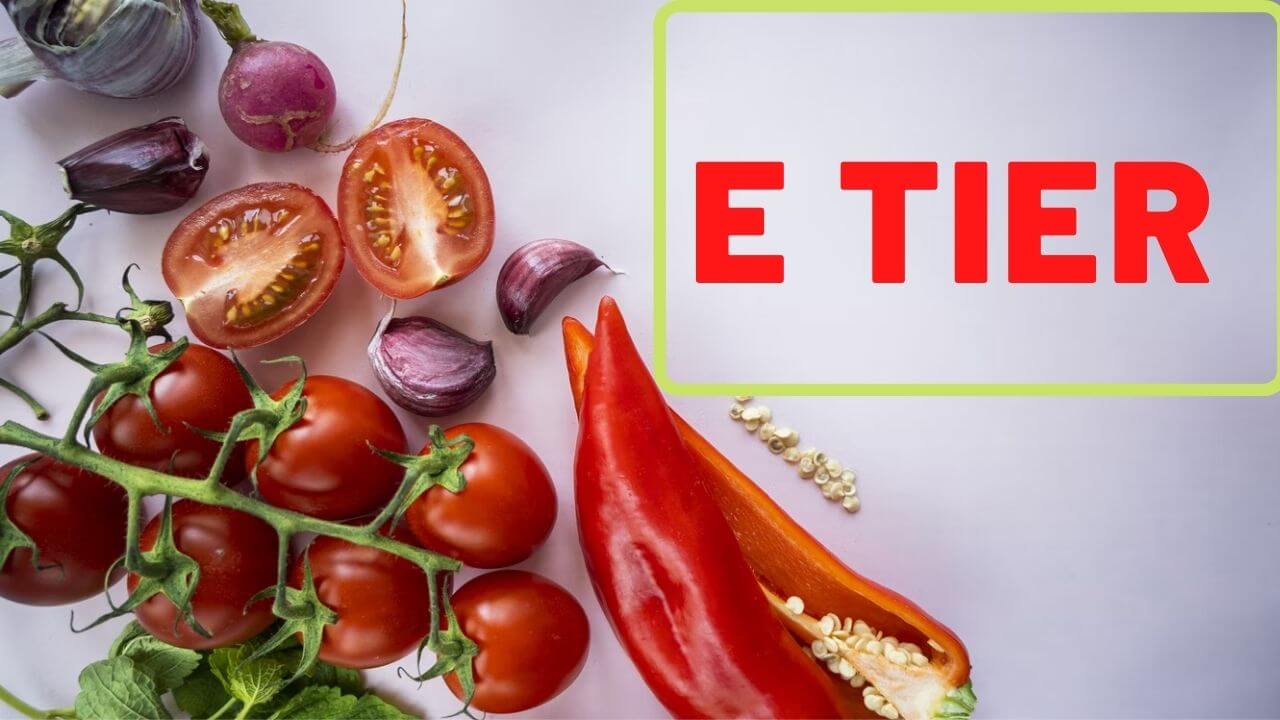
The second tier that we have is the E-tier. One has to be lucky to grow these crops, as they rarely yield any product. These crops are not great in taste and are often used less than the other tiers for cooking. Their self-sowing tendency is quite low and during extreme weather conditions, they completely lose this ability.
Beetroot
Beetroot which is also known as Beta vulgaris is a root vegetable. It has different names such as red beet, table beet, and garden beet. It is blessed with several different nutrients such as fiber, folate, manganese, potassium, iron, and vitamin C.
Let us know why it is added to the E-tier list. First of all, let us talk about the harvesting period, beetroot has a short harvesting period that makes it difficult to maintain. It is more vulnerable to pests as compared to the vegetables in the tiers above the d-tier. It also has limited uses, such as salads or juices.
| CALORIES | 58.5 |
| PROTEIN | 1.7g |
F Tier
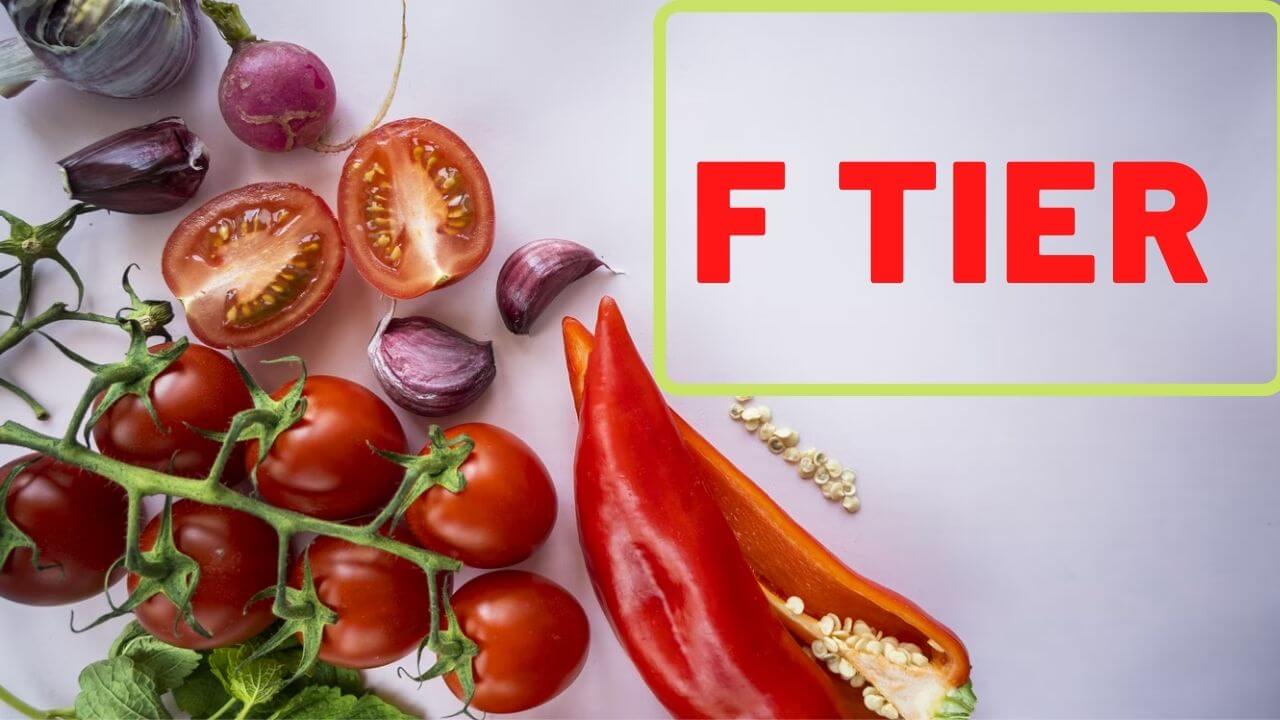
Finally, last but not the least, we have the F-tier fruits and vegetable category. They need constant attention, pest services, and fertilizers. Without these, they cannot grow. They are the least favorite crops and can be lying in the shops. They are not garden-friendly crops, and it is not a good idea to grow these crops at home.
Broccoli
The last tier on the list is the F-tier, and the first vegetable on this list is broccoli. Brocolli is not a favorite vegetable of many people around the world,d except for the diet enthusiasm and fitness freaks. It is a cruciferous vegetable that is associated with cabbage, kale, cauliflower, and Brussels sprouts. This vegetable is packed with several different nutrients such as fiber, vitamin C, vitamin K, iron, and potassium.
Broccoli is added to the F-tier list for several reasons. The first reason is that it is not liked by a lot of people. The second reason is that it rarely gives any product. It is fully dependent on fertilizers and needs constant attention. It is wholly solely grown with the help of pesticides and fertilizers, without that it will not survive.
| CALORIES | 34 |
| PROTEIN | 2.8g |
Capsicum
Let us talk about capsicums, the main staple topping in a lot of pizzas and salads. Capsicum has another name which is red pepper. It is a herb. Capsicums are quite helpful against arthritis, and they are packed with several different nutrients as well. Due to their taste, they are not liked by a lot of people.
Capsicum is added to the F-tier list due to many reasons. The top reason is that it is not liked by people. Another reason is that this vegetable is highly vulnerable to damage by insects and pests. It needs intense care and consideration, otherwise, it can get affected by the pests very quickly.
| CALORIES | 40 |
| PROTEIN | 2g |
Keto vegetables (Bonus)
Let us start by explaining what a keto diet is. A keto diet has a low amount of carbohydrates, and a high amount of protein, and fats. The purpose of a ketogenic diet is to get rid of excess fat which is accumulated in the body, rather than focusing on carbohydrates. To achieve the purpose of a ketogenic diet, one has to include certain vegetables and other nutrients in the diet that will support the aim.
Since everyone has their specific diet that forms their lifestyle. For some people, a ketogenic diet is the main part of their lifestyle. They follow it to keep their body in shape and eat cautiously.
So the question is, which vegetables are suitable for this diet? Well, these vegetables are keto vegetables. These vegetables are chosen after detailed research, they specifically consist of low carbohydrates. Mushrooms, asparagus, spinach, celery, etc. are the best options for a keto diet. Let us read more about these vegetables in the following paragraphs.
| CALORIES | 22 |
| PROTEIN | 2.4g |
Asparagus
Whether eaten raw or steamed, asparagus is an amazing source of high protein, iron, potassium, and vitamin C diet for all the keto dieters out there. For every 100g of asparagus, one can have as low as 3.88g of carbohydrates. It is used in a variety of different dishes and is one of the most loved keto vegetables. Among all the vegetables in the vegetable lists, asparagus has the highest amount of carbohydrates.
| CALORIES | 20 |
| PROTEIN | 2.2g |
Celery
What’s watery and green? Well, yes, that is celery. Celery is used in almost all kinds of diets because of its amazing health benefits. For every 100 grams of consumption of celery, the human body gets 2.97 grams of carbohydrates. It is a great source of some vital nutrients such as potassium and calcium, along with them it also has a very low amount of calories that makes it ideal for a keto diet.
| CALORIES | 14 |
| PROTEIN | less than 1g |
Spinach
If you are looking for a vegetable that contains a high level of calcium, then you cannot go wrong with spinach. It is one of the most famous vegetables for its nutrients and health benefits. Consuming 100 g of spinach will provide the human body with only 3.63g of carbohydrates.
| CALORIES | 23 |
| PROTEIN | 2.9g |
Mushrooms
The last vegetable that we have on our keto vegetable list is mushrooms. If a person consumes 100g of mushrooms, then their body will gain only 3.26g of carbohydrates. They are used all over the world in a variety of different dishes and are a staple item on a keto breakfast menu.
| CALORIES | 22 |
| PROTEIN | 3.1g |
Vegetable carb list (Bonus)
Carbohydrates are great sources of energy. They are found in a variety of vegetables, and fruits and in some unhealthy foods as well. Some forms of carbohydrates include sugars, fibers, and starches.
It is important to eat vegetables that contain an adequate amount of carbohydrates to maintain a healthy diet. An individual diet consists mostly of vegetables, it is important to eat vegetables that can suit a person’s lifestyle and diet.
Eating vegetables and not keeping track of the level of carbohydrates those vegetables carry can be a huge mistake. To help our audience with this, we have created a well-researched vegetable carb list. The vegetable carb list has several different vegetables along with the number of carbs and serving. Let us read ahead!
| Vegetables | Serving | Amount of carbs |
| Carrots | 1 cup, raw | 12 grams
|
| Corn | 1 cup chopped | 30 grams |
| Sweet potato | 1 cup | 27 grams |
| Beetroot | 1 cup, chopped or sliced
|
13 grams |
| Parsnips
|
1 cup | 23 grams |
| Brussels sprouts
|
1 cup, raw or cooked
|
12 grams |
| Zucchini
|
1 cup, sliced | 3.5 grams |
| Butternut Squash
|
1 cup, cooked
|
21 grams |
| Acorn Squash
|
1 cup, cooked
|
30 grams |
| Pumpkin | 1 cup, cubed
|
8 grams
|
| Spinach | 2 cups, raw
|
2 grams |
| Chickpeas | 1 cup, cooked
|
45 grams
|
| Red bell pepper | 1 cup, raw or cooked
|
9 grams |
| Navy beans | 1 cup, cooked | 47 grams
|
| Garlic | 1 clove raw | 1 gram |
| Kale (raw) | 1 cup | 1.4 grams |
| Romaine Lettuce (raw) | 1 cup shredded | 1.6 grams |
| Cucumber (raw with peel) | 1/2 cup | 1.9 grams |
| Mushrooms (button, cooked) | 1/2 cup sliced | 2.2 grams |
| Cauliflower (boiled) | 1/2 cup (1″ pieces) | 2.2 grams |
| Onion (yellow, sautéed) | 1/2 cup chopped | 3.4 grams |
| Tomato (raw) | 1/2 cup sliced | 3.5 grams |
Comparison Table
| Vegetable | Tier | CALORIES | PROTEIN(g) |
|---|---|---|---|
| Boy Choy | S | 9 | 1 |
| Kale | S | 49 | 2.21 |
| Potato | S | 110 | 1.5 |
| Carrot | S | 41 | 0.9 |
| Eggplant | S | 25 | 3.1 |
| Mushrooms | A | 22 | 3.1 |
| Seaweed | A | 306 | 2.3 |
| Bell Pepper | A | 20 | 0.9 |
| Tomatoes | A | 22 | 1.31 |
| Lettuce | A | 15 | 1.4 |
| Corn | B | 88 | 3.2 |
| Green beans | B | 31 | 1.8 |
| Avacado | B | 240 | 3 |
| Cauliflower | B | 25 | 1.9 |
| Scallions | B | 32 | 1.8 |
| Raddish | C | 16 | 0.7 |
| Parsley | C | 36 | 3 |
| Turnip | C | 28 | 0.9 |
| Malabar spinach | D | 19 | 1.8 |
| Peas | D | 81 | 5 |
| Beetroot | E | 58.5 | 1.7 |
| Broccoli | F | 34 | 2.8 |
| Capsicum | F | 40 | 2 |
| Keto vegetables (Bonus) | F | 22 | 2.4 |
| Asparagus | F | 20 | 2.2 |
| Celery | F | 14 | less than 1g |
| Spinach | F | 23 | 2.9 |
| Mushrooms | F | 22 | 3.1 |
Verdict
At the end of the article, we would like to leave a few remarks. A vegetable tier list is of great use when it comes to ranking different items such as vegetables in our case. Vegetables are an important part of our everyday life. Every individual has their likings and dislikes regarding vegetables. Our tier list provides liberty to the audience to choose those vegetables and rank them accordingly what they like the most in descending order.
Apart from that, there is a list of different keto vegetables that will help all the keto-lovers out there about different vegetables that they can include in their diet. A vegetable carb list consists of a majority of vegetables that can be a great source of carbohydrates for the human body.
FAQs
What are the most nutritious vegetables ranked?
Nutrition-wise, some top vegetables include kale, spinach, broccoli, and Brussels sprouts, but taste is also a factor. These are packed with essential vitamins and minerals, such as vitamin K, vitamin C, and fiber. However, it’s important to remember that variety is key to a balanced diet, so try to incorporate various vegetables in your meals.
Which vegetables are best for overall health?
From a holistic perspective, dark leafy greens, like spinach and kale, are excellent for overall health. Other great choices include cruciferous vegetables, such as cauliflower and broccoli, and colorful options, like red bell peppers. They all contain essential nutrients and antioxidants that support your body’s functions and keep you healthy.
Which vegetables are considered top-tier in terms of nutrition?
Many consider kale, spinach, and Swiss chard as “top-tier” due to their high nutrient density. These dark, leafy greens have high levels of vitamins A, C, and K and are rich sources of antioxidants. Also, cruciferous vegetables like broccoli and Brussels sprouts are highly nutritious and offer numerous health benefits.

